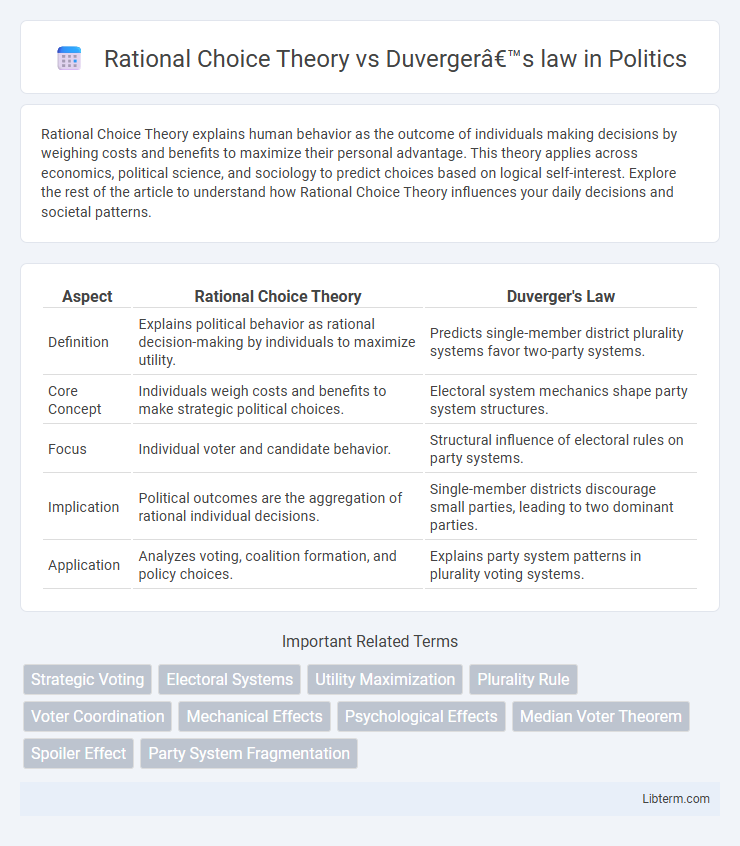Rational Choice Theory explains human behavior as the outcome of individuals making decisions by weighing costs and benefits to maximize their personal advantage. This theory applies across economics, political science, and sociology to predict choices based on logical self-interest. Explore the rest of the article to understand how Rational Choice Theory influences your daily decisions and societal patterns.
Table of Comparison
| Aspect | Rational Choice Theory | Duverger's Law |
|---|---|---|
| Definition | Explains political behavior as rational decision-making by individuals to maximize utility. | Predicts single-member district plurality systems favor two-party systems. |
| Core Concept | Individuals weigh costs and benefits to make strategic political choices. | Electoral system mechanics shape party system structures. |
| Focus | Individual voter and candidate behavior. | Structural influence of electoral rules on party systems. |
| Implication | Political outcomes are the aggregation of rational individual decisions. | Single-member districts discourage small parties, leading to two dominant parties. |
| Application | Analyzes voting, coalition formation, and policy choices. | Explains party system patterns in plurality voting systems. |
Introduction to Rational Choice Theory
Rational Choice Theory models individuals as rational actors who make decisions by maximizing utility based on preferences and constraints. This theory underpins Duverger's Law by explaining voter and party behavior within plurality electoral systems, where strategic calculations often lead to a two-party system. Understanding Rational Choice Theory is essential to analyzing how election rules influence political competition and voter alignment.
Fundamentals of Duverger’s Law
Duverger's Law fundamentally explains that single-member district plurality systems tend to favor a two-party system due to mechanical and psychological effects on voters and candidates. Unlike Rational Choice Theory, which analyzes individual strategic decision-making based on maximizing utility, Duverger's Law emphasizes systemic electoral structures shaping party competition and voter behavior. The mechanical effect disqualifies smaller parties through vote distribution, while the psychological effect pressures voters to support viable candidates, reinforcing bipartism.
Comparing Theoretical Foundations
Rational Choice Theory explains voting behavior through individual self-interest and strategic decision-making based on cost-benefit analyses, assuming voters act to maximize utility. Duverger's Law, rooted in institutional theory, posits that single-member district plurality electoral systems naturally favor a two-party system due to mechanical and psychological effects on voters and parties. Comparing these foundations reveals Rational Choice Theory's emphasis on individual rationality contrasts with Duverger's Law's structural focus on electoral system design influencing party dynamics.
Voting Behavior: Rational Choice Perspective
Rational Choice Theory explains voting behavior as a deliberate decision-making process where individuals vote to maximize their personal utility, often weighing the perceived benefits of each candidate or party against the costs of voting. Duverger's Law complements this by showing how the electoral system, particularly single-member plurality, influences voters to support major parties to avoid wasting their vote on less viable candidates. Together, these theories highlight the strategic calculations voters make within institutional constraints to optimize electoral outcomes.
Electoral Systems and Party Outcomes
Rational Choice Theory explains voter and party behavior by assuming individuals act to maximize their utility within given electoral systems, often leading to strategic voting and candidate selection. Duverger's Law posits that single-member district plurality systems tend to produce two-party systems due to mechanical and psychological effects on voters and candidates. These theories intersect in explaining how electoral systems shape party outcomes, with Rational Choice focusing on individual incentives and Duverger emphasizing systemic constraints.
Strategic Voting Explained
Rational Choice Theory explains strategic voting as a behavior where voters select candidates not solely based on preference but on the likelihood of influencing the election outcome, often avoiding "wasted votes." Duverger's law predicts that in plurality-rule elections, strategic voting consolidates support around two major parties, reducing third-party viability. The interaction between these concepts highlights how electoral incentives shape voter calculations to maximize the effectiveness of their vote within specific political systems.
Two-Party vs Multi-Party Systems
Rational Choice Theory explains voter behavior in electoral systems by assuming individuals select the candidate or party most likely to maximize their preferences and benefits. Duverger's law asserts that plurality-rule elections in single-member districts tend to favor a two-party system, as voters strategically avoid "wasting" votes on less viable parties, reinforcing a stable two-party dominance. Multi-party systems often emerge under proportional representation, where voter preferences can align with smaller parties, allowing diverse representation not constrained by first-past-the-post mechanics inherent in Duverger's law.
Exceptions to Duverger’s Law
Duverger's Law posits that single-member district plurality voting systems typically produce two-party systems, yet notable exceptions challenge this pattern. Multiparty systems persist in countries like India and Canada due to factors such as regional parties, coalition politics, and voter heterogeneity. Rational Choice Theory explains these deviations by highlighting strategic voting, candidate selection, and institutional influences shaping electoral outcomes beyond Duverger's predictions.
Criticisms and Limitations of Both Theories
Rational Choice Theory faces criticism for its assumption of consistent, utility-maximizing behavior, often oversimplifying complex political decision-making and ignoring social or emotional factors. Duverger's law is limited by its tendency to overlook electoral system variations and the influence of local political cultures, sometimes failing to predict multiparty outcomes in supposedly majoritarian systems. Both theories struggle with empirical anomalies and the dynamic nature of political environments, highlighting the need for more nuanced, context-sensitive approaches in political science.
Implications for Modern Democracies
Rational Choice Theory explains voter behavior through cost-benefit analysis, predicting strategic voting to maximize personal utility, which often leads to a two-party system under Duverger's Law in single-member district elections. Duverger's Law posits that plurality-rule elections tend to favor a two-party system, limiting political diversity and often marginalizing smaller parties in modern democracies. The interaction between these theories highlights electoral system design's profound impact on party dynamics, voter representation, and policy outcomes in contemporary democratic governance.
Rational Choice Theory Infographic

 libterm.com
libterm.com